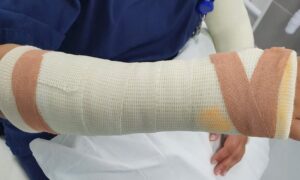I could give you a long list of places to visit in Latvia. There are so many interesting, quirky, or historical places to go. There is a modern, upbeat feel to many places these days, but there is also the lingering shadow of its Soviet past.

There are traditional activities and crafts such as the annual craft market at the Open Air Folk Museum on the edge of Riga to the modern Lampa festival in Cēsis, a festival of conversation to discuss a myriad of topics.
The fact is there are plenty of websites that list some of these places to go (there is a short list at the bottom), so why write another article on the topic?
What I want you to do is a little different; it is to encourage you to go slowly and savour the country. Don’t rush through, trying to see all the must-see places, take your time and savour the wonderful vastness of the countryside, where three cars in a row is a rush hour. Get out of the capital, Riga, into some of the smaller places. Hang out in nature; it will do you good.

Latvians like their summer houses. That doesn’t mean they are rich, just that they own a little, possibly ramshackle, place in the countryside that they can call their own and visit on summer weekends. A home that may have been returned to them on independence after the Soviet collective farms had been dismantled.
They go to be in nature, to connect with their past and to de-stress from modern life. It’s not a bad idea.
Many Latvians can tell you which wild foods are good to eat; the berries, the mushrooms that are safe and the herbs in the pastures that make good teas or you can add to a summer salad. A font of knowledge often lost in more “modern” countries. Often, they do not know how special this knowledge is and how eminently sustainable. We can learn much from them, if we take time.

TAKE A BUS OR TRAIN TO OUT-OF-THE-WAY PLACES
So how do you slow down and still get to see Latvia? The best way is to take the bus. It can be tricky sometimes sorting out the connections, but buses are still fairly frequent in Latvia and can get you from one hub to another.
They just don’t always run at the most convenient times, but they do go to out-of-the-way places.
The trains are an alternative; they are slow and seem to stop in the middle of absolutely nowhere at times, the small town nestled a short walk away through a forest. Trains and buses in Latvia, at least between the towns, often have Wifi (unless the bus loses the signal in a forest, and there is a lot of forest). This helps when trying to plan your journey as you can do it on the move.
To plan a journey two websites are helpful here, Riga transport website for in Riga itself and one that covers the rest of Latvia, 1188.lv.
It is possible to buy tickets at the stations along the route or buy the ticket on the bus or train. If you buy a ticket in advance for the bus (up to 15 minutes before the bus leaves) you will have two numbers on the ticket, platforma – the platform number where the bus will leave from and vieta – place.
Now vieta takes a bit of explaining. It is not your seat number, it is the number you get on with. Neither do they start at number one; the first few numbers are reserved for invalid and pregnant mothers, so I was told. Often, they start at number 3 (trešais or strictly speaking “third”) or number 4 (ceturtais).
If you can’t speak Latvian, don’t worry. Either ask a young person for help (often they speak at least a little English) or just get on approximately when you think and apologise with a big smile. Ignore any grumpiness.
Once you are on, relax and enjoy the scenery. Be warned though, if you do not buy a ticket in advance and choose to travel on a busy route or at peak time, you could be standing for an hour before enough folks get off for you to sit down.

BE ADAPTABLE
Another tip is to be adaptable when it comes to food. In even the tiniest of places there is often at least a small supermarket … but not always.
Sometimes there are some fabulous restaurants, often a kafejnīca (café) or a konditoreja (cake shop). Basic menus are filling and tend to include a range of salads and soups, actually made with vegetables (now there’s a novelty in this day and age), but they maybe smothered in oil or sour cream.
And then there is the standard post-Soviet fare of karbonade (basically a piece of meat that has been hammered to a thin slice and dipped in a batter and fried).
However, there are some places with fabulous food, so go with the flow. And remember, go slowly.
Things to do in Latvia:
• Beyond Riga: As young Latvians begin to leave the capital, where will the nation’s next hotspot be? – The Calvert Journal
• 25 Best Things to Do in Latvia – The Crazy Tourist
• If you like Latvia, Latvia Likes You – Facebook

About the author:
Joanna Storie is a British emigrant and Ph.D. candidate living in Latvia.
You can read more of Joanna’s posts here.














